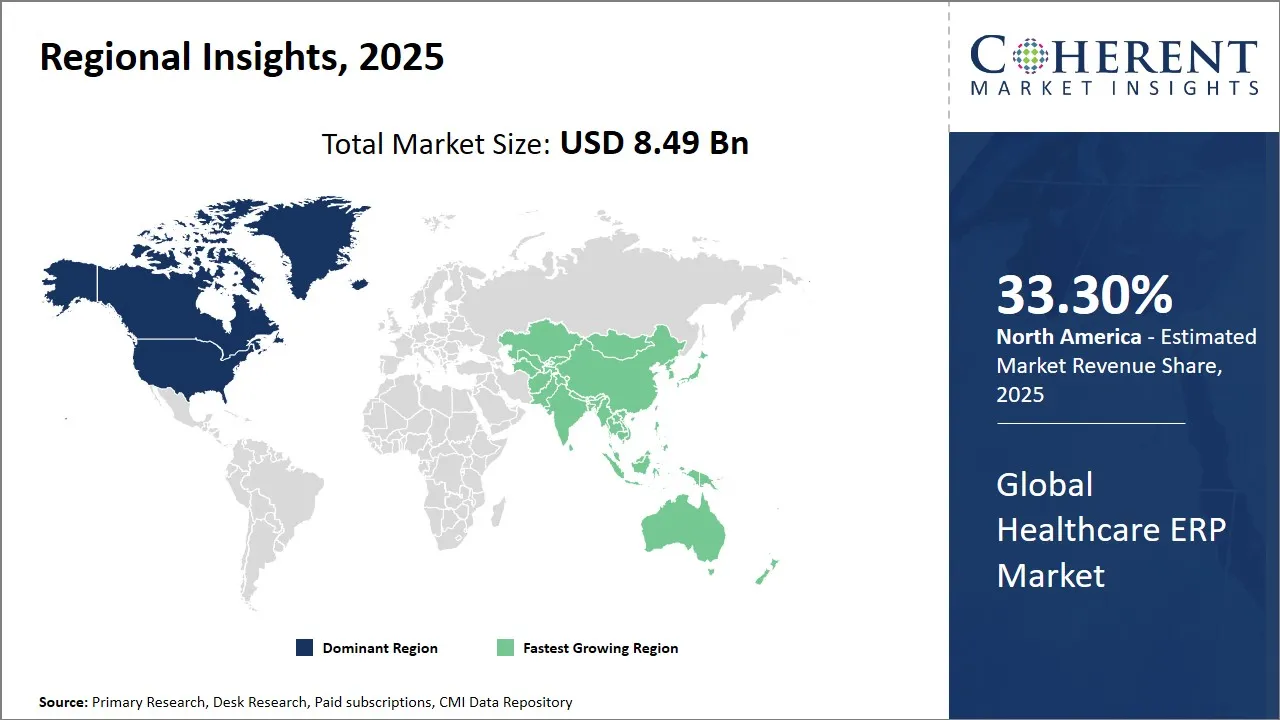
Healthcare Erp Market is estimated to be valued at USD 8.49 Bn in 2025 and is expected to reach USD 13.46 Bn in 2032, exhibiting a compound annual growth rate (CAGR) of 6.8% from 2025 to 2032.
The healthcare ERP market is experiencing robust global growth, driven by the increasing need for streamlined operations, digital transformation, and efficient resource management in healthcare facilities. Key drivers include rising healthcare expenditure, the demand for integrated patient and administrative data systems, and the growing need for real-time decision-making. ERP systems offer comprehensive solutions for inventory control, billing, supply chain, and patient relationship management.
|
Current Event |
Description and its impact |
|
Growing Digitalization of Healthcare Services |
|
|
Launch of Cloud-Based and AI-Enabled ERP Solutions |
|
|
Government Incentives for Healthcare IT Adoption |
|
Uncover macros and micros vetted on 75+ parameters: Get instant access to report
Healthcare organizations across the world are growing aware of the benefits associated with these advanced technological solutions (healthcare ERP), such as reducing operational costs, delivering high-quality patient care, improve patient outcomes, rise in caregiving efficiency, better utilization of resources, and eliminating data siloes in back-end operations, which is turn contribute to the increasing demand for novel or technologically advanced ERP solutions. This trend is expected to continue over the forecast period, driving the market growth.
In February 2024, AdventHealth, a major healthcare provider in the United States, completed the migration of its 37 hospitals to the Epic Systems electronic health record (EHR) system. This cloud-powered transition, supported by a partnership with Virtustream, involved an investment of $660 million and aimed to improve clinical and administrative workflows, enhance patient care, and provide seamless data access across its network.
The rising adoption of innovative and technologically advanced ERP solutions is creating significant growth opportunities for market players. As more healthcare organizations implement ERP systems to lower operational costs and enhance patient outcomes, demand for these platforms continues to rise.
By function, the Inventory and Material Management segment is expected to dominate the healthcare ERP market, holding the largest market share during the forecast period. This leadership is driven by the critical need for efficient tracking, storage, and distribution of medical supplies and equipment across healthcare facilities. ERP solutions with advanced inventory management capabilities help minimize wastage, streamline procurement, and ensure the continuous availability of essential resources.

To learn more about this report, Download Free Sample
North America is poised to lead the global healthcare ERP market, commanding the highest share during the forecast period. This leadership is driven by widespread healthcare digitalization, rapid adoption of ERP solutions, growing demand for paperless technologies, and strong government funding supporting healthcare infrastructure and services.
Europe and Asia Pacific are expected to experience robust growth in the healthcare ERP market due to increasing healthcare IT adoption, ongoing digital transformation, supportive government policies, and well-established healthcare infrastructure. The Central European Healthcare Association exemplifies this trend by optimizing services with SAP S/4HANA, implementing multiple SAP ERP systems.
The United States leads the healthcare ERP market worldwide owing to its highly developed healthcare infrastructure, high government expenditure, and prominent presence of ERP vendors. The healthcare industry of the country is increasingly embracing ERP systems to drive operational effectiveness, cut costs, and enhance patient outcomes.
Canada holds a dominant position in the healthcare ERP sector driven by strong healthcare IT and digital transformation spending. Healthcare facilities in the nation are progressively implementing ERP systems to automate financial operations, supply chain management, and administrative functions. Incentives from the government towards healthcare modernization and enhanced patient care quality are fast-tracking ERP adoption. The Canadian market is facilitated by public-private collaboration that aims at improving the delivery of healthcare services using technological integration.
| Report Coverage | Details | ||
|---|---|---|---|
| Base Year: | 2024 | Market Size in 2025: | USD 8.49 Bn |
| Historical Data for: | 2020 To 2024 | Forecast Period: | 2025 To 2032 |
| Forecast Period 2025 to 2032 CAGR: | 6.8% | 2032 Value Projection: | USD 13.46 Bn |
| Geographies covered: |
|
||
| Segments covered: |
|
||
| Companies covered: |
SAP, Sage Group PLC, QAD Inc., Odoo, Infor, Aptean, Microsoft, Oracle Corporation, McKesson Corporation, and Epicor Software Corporation, among others. |
||
| Growth Drivers: |
|
||
| Restraints & Challenges: |
|
||
Uncover macros and micros vetted on 75+ parameters: Get instant access to report
Share
Share
About Author
Manisha Vibhute is a consultant with over 5 years of experience in market research and consulting. With a strong understanding of market dynamics, Manisha assists clients in developing effective market access strategies. She helps medical device companies navigate pricing, reimbursement, and regulatory pathways to ensure successful product launches.
Missing comfort of reading report in your local language? Find your preferred language :
Transform your Strategy with Exclusive Trending Reports :
Frequently Asked Questions
Joining thousands of companies around the world committed to making the Excellent Business Solutions.
View All Our Clients